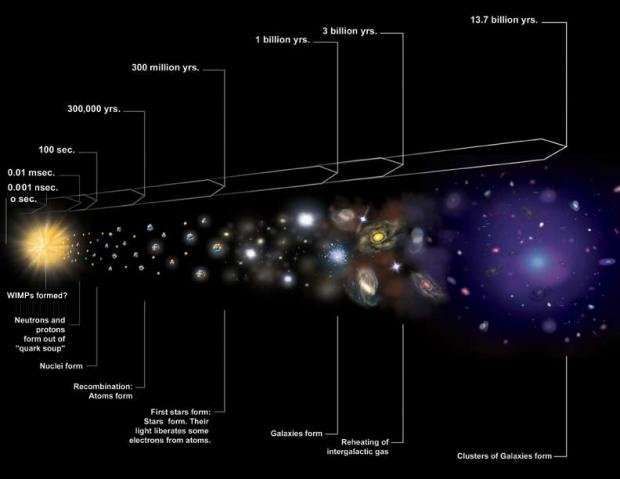The frustrating and fascinating world of dark matter research

Most people who are paid a salary can be quite confident that the subject of their work actually exists. Physicists studying dark matter differ from most people in this respect. Regardless, talented young scientists continue to devote their careers to the subject. Why?
It's not that dark matter lies waiting to be discovered. Far from it, dark matter as a phenomenon is firmly established, and we have plenty of convincing evidence to suggest that it is five times more abundant than its bright counterpart.
Rather, the problem is that the overwhelming body of evidence for dark matter hinges entirely on gravitational effects. If it turns out that gravity acts much stranger than Newton envisioned, the effects we attribute to a dark matter particle, could be a mirage. And we may be forced to dismiss the entire dark matter hypothesis to the hall-of-fame for obsolete scientific theories.
To finally confirm our paradigm, dark matter devotees like myself need to catch or create a dark matter particle, so we can prove, once and for all, that dark matter is actually made of matter.
Anything goes in the dark
So, what does dark matter look like anyway? Well, that depends on your preference.
The diversity of hypothesized dark matter candidates is truly mind-boggling. Serious contenders include particles with radii as large as galaxies, as well as ultra tiny particles with radii one quadrillion (15 zeros) times smaller than the proton.
It doesn't even have to consist of particles at all, dark matter could be small punctures in the fabric of space and time called primordial black holes.
Any experiment setting out to find dark matter must therefore first choose a hypothesis and proceed to prove or disprove it.
However, the checklist of candidates is very long, and many ideas cannot be tested experimentally with current technology.

The usual suspect is a WIMP
Particle physics has a long and proud tradition of giving silly names to hypothetical particles. A particularly silly example is the particle known as WIMP, which, despite its name, is one of the strongest dark matter candidates.
The weird sounding name is actually an acronym for the properties of the particle: Weakly Interacting Massive Particle. Meaning that the particle is massive so it gravitates towards other particles or objects, but it only interacts weakly with our visible world.
In the very first split seconds after the Big Bang, our Universe was once incredibly hot and dense. This primordial soup is where the supposed birth of the WIMP occurred. Armed with knowledge of how our Universe expanded and cooled, we can accurately calculate the number of WIMPs that were formed under these conditions.
Remarkably, this calculation leaves us with a number of WIMPs that closely matches the observed amount of dark matter. In other words, we postulate a particle with the properties we expect to find in dark matter, and without additional assumptions, our knowledge of the history of the Universe means it turns up in the right amount. Well, this seems too good to not be true.
Miracles don't happen, right?
This incredible coincidence of numbers is what the supporters of the WIMP zealously refer to as "the WIMP miracle." Miracle is perhaps too strong of a word—but the WIMP paradigm does give a very simple explanation that can account for all of the dark matter at once, and thus passes the test of Occam's razor: Theories with the fewest assumptions are most likely to be correct.
But what's even better than its simplicity is that it's testable. The very interactions responsible for creating the WIMPs in the first place, allow us to build experiments to find them—the so-called "direct detectors."
Sadly, the detectors built to find WIMPs have found nothing. And so far, it looks like "the WIMP miracle" led us on a decades long wild goose chase.
Physicists still hope to discover the WIMP, but if it does eventually turn up, it would certainly look different to what we had imagined.

On the other hand, if the WIMP never turns up, the direct detection experiments will have crossed off a few contenders from the checklist, albeit at huge expense. But, as an added bonus, the search for WIMPs has driven detector technology to impressive lengths. Some of these advancements are already being repurposed in other branches of physics, like neutrino physics. So even with a negative result in its primary mission, the effort to find the WIMP has not been in vain.
Occam's razor doesn't always cut it
The visible part of our Universe consists of a very limited list of ingredients: quarks, leptons (such as electrons and neutrinos), and four forces that allow the particles to interact. From these modest building blocks comes all diversity—from the stars in the sky, to life on Earth—all can be reduced to complicated configurations of these simple constituents.
There is no fundamental reason that the dark part of our world should be less diverse than the visible part. One can even imagine dark matter coalescing into dark stars, planets, and life, which exist entirely secluded from our world. To them, we're the dark matter.
However, designing experiments to look for dark matter is a practical matter, and it's hard to look for more than one thing at a time. Therefore, we tend to stick to Occam's razor and try to find the simplest possible answers to the dark matter question.
Unfortunately, Occam's razor is not a mathematical theorem, and nature doesn't care how "likely" various theories are according to physicists. In truth, our simplified models of dark matter may give way to a much more complex and messy reality.
In this case, we will never see a grand discovery of dark matter, but a gradual understanding of small pieces of an enormous puzzle.
We still think dark matter is made of particles that gravitate—but the only thing we know for sure, is that it will be a subject matter for physicists for many years to come.
There is absolutely no guarantee that we will discover a dark matter particle. But we might. And that could change our understanding of everything.
Provided by ScienceNordic
This story is republished courtesy of ScienceNordic, the trusted source for English-language science news from the Nordic countries. Read the original story here.




















